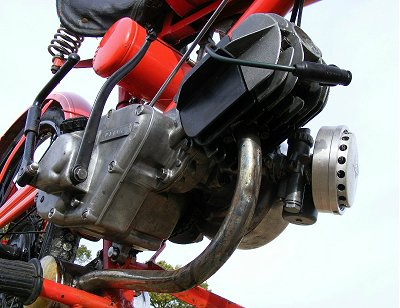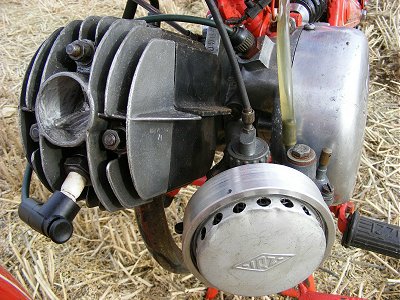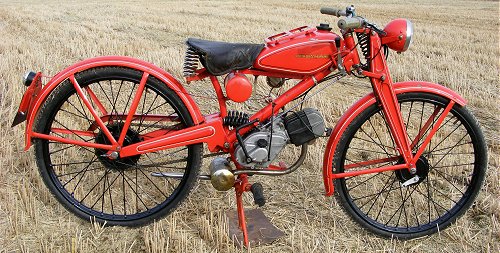


While many European manufacturers were following their various developments along the pedal-assisted autocycle theme in the pre-war and post-war periods, there were others evolving lightweight transport methods along very different lines...
As post-war Europe picked itself up and got back to business, a demand for cheap and economic personal transport quickly developed. Many western European manufacturers simply resumed construction of their outdated, pedal-assisted autocycles, but in post-war Italy, there appeared an original autocycling alternative that had been produced without pedals!
With the launch of the 65cc Motoleggera designed by Antonio Meucci, Moto-Guzzi had shown the initiative to step forward ten years.
First appearing in early 1946, this revolutionary development was absolutely no autocycle, but a truly practical lightweight motor cycle that would quickly adopt the title of 'Guzzino' - Little Guzzi.

The motor specification comprised a 65cc two-stroke with cast iron cylinder and alloy head, with rotary valve induction through a hollow left hand side crank journal from a Dell'orto MU14B2 carb. A CEV Modello 6100 magneto set provides sparks, and transmission goes out via a three-speed gearbox, selected 'old-style' by a hand change lever on the right hand side of the petrol tank.
Some aspects of the cycle, like the 26-inch wheels with adjustable cup & cone bearing arrangements, and the flywheel mag driven batteryless lighting system, will be familiar as contemporary derivations; but not only did this machine have the vision to jump beyond the single-ratio, pedal-assisted autocycle generation, but the radical cycle design also looked modern enough to carry it off.
With the imaginative styling proving popular and an established reputation for reliability, demand for the machine quickly reached to other Mediterranean shores. In 1948, Moto-Hispania in Spain was licensed to manufacture and market machines derived from the original Italian Moto-Guzzi, under the name of ISA-Guzzi. So it was that the Guzzino came to be manufactured in two different countries at the same time!
Though the Hispania Guzzino was ostensibly the same machine, there was a number of characteristic differences. On the engine side, the cylinder was cast in alloy with an iron liner, and fed from an IRZ 14mm carb, while a Femsa MAV200A magneto set now lit the fires.
Apart from different electrical fittings, the cycle assembly remained pretty much unchanged, but frame serialisation was given an MGH prefix.

Our feature machine displays frame number MGH4130 so is certainly one of the Spanish built models. The fitted engine however wears a cast iron cylinder with offset plug head, and stamped DDG10 (crankcase) & DIB64 (clutch case), with 'stars' before and after the numbers in typical Italian practice. With 'Moto-Guzzi' moulded into the oil filler cap and pressed into the aluminium magneto cover, and though the inlet manifold mounts the IRZ Spanish carb, there's little doubt that the installed motor is of Italian origin.
Sure enough, another box of parts accompanies the bike, containing an alloy cylinder, another inlet manifold has a Dell'orto carb hanging off it, and a dismantled engine stamped ISA1602 on the clutch case. "ISA Guzzi" is moulded into the oil filler cap and pressed into the aluminium magneto cover, so it seems as if we've found the original Spanish engine.
Once you've come to terms with the unusual, insect-like appearance of the design, all the controls are actually quite familiar and conventionally disposed. A tap turns on under the left hand side of the fuel tank, there's a flood button on top of the carb, and little flip lever on the back of the air filter to choke on the strangler. The kick-start construction is unusual in that the head rotates about midway down the shank, but it works in exactly the same manner as any other device. A few jabs on the starter while twisting open the throttle and jiggling with the choke lever soon has the motor firing, and we sit for a while to run our recalcitrant conveyance until it settles down.

The exhaust tone gives a mellow popping note, graduating to a hooverish hum as the revs are twisted up on the throttle. Left hand pulls in the clutch lever, right hand to the gear lever on the tank and click backwards for first, then wind open the twist-grip while feeding in the clutch - and first gear feels as if it has a reasonably selected ratio, taking us up to around 12mph before we're back to the tank lever and fumbling to switch up to second.
Second gear can be built up to 27mph, so the notch into third is made with quite some optimism as to what our Guzzino might achieve, but such hopes are quickly dashed. Top proves to be an overdrive, and far too overgeared for the motor to pull against effectively. You soon find you have the throttle wound fully open with the little 65cc engine just labouring against the ratio. The bike generally holds between 28mph & 32mph on the flat according to conditions, but readily fades even against the lightest incline or headwind.
Our pace bike clocked off 37mph on the downhill run, and Guzzino was still building up when we reached the bottom of the dip, so it wasn't revving out by any means and would certainly have crept up a little higher on a longer descent. Confronted with climbing the gradient on the other side of the dip, the result was quite predictable. Guzzino faded fast in third, requiring a switch down to second so we could plod up the other side at around 20mph.
We were aware that the recently honed cylinder assembly has not yet bedded in, and that the fuel in the test bike was several years old and probably verging on stale, so this machine's performance may not be wholly representative.
Compared to the generally ineffective brakes on most British built autocycles, Guzzino's stoppers were a considerable improvement. The leverage advantage afforded by the foot operated rear arm ensured this brake proved quite effective, while the front drum was also more than adequate for the bike's performance.

Guzzino's general ride was most commendable when compared to the unforgiving frames of its distant autocycle cousins. The pressed girder fork set didn't look at all busy with the road surface, but smoothed out the bow waves quite efficiently. While the rigid frame of a typical autocycle would be delivering a steady battering to its rider, our undamped swing arm arrangement proves contrastingly bouncy and, coupled with the springy saddle; you flow gently along in an undulating fashion. While one might think this limousine-style ride may compromise the handling - not so! Push Guzzino confidently through corners and its manners prove fine, hesitation however may be returned with a wobbly uncertainty as to quite where it may be going - but you've only yourself to blame for that!
Considering the batteryless magneto-driven lighting system is much the same in principle as a typical Villiers-powered glimmer, the headlight proved illuminatingly better for night riding, and reasonably suitable to the motor cycle's performance.
We did drain the tank and replace with fresh fuel the following day, to find starting and acceleration appreciably improved. Unfortunately, with appalling weather, having no fitted speedo and no pace bike available, there was no opportunity to repeat the test before the bike was returned to its owner. The conclusion was that a better running performance may well have been achievable.
Being a relatively light and small capacity machine, Guzzino would have been perceived in a similar local commuting role to contemporary autocycles; however, its more comfortable ride would enable the advantage of longer journeys without the associated rider fatigue.
Moto-Guzzi manufactured the 65cc Motoleggera 'Guzzino' from 1946 to 1954, when it was remodelled into the 65cc Cardellino from 1954 to 1956. Engine capacity was increased for the 73cc Cardellino from 1956 to 1962, then the 83cc Cardellino from 1962 to 1965. Over this period, the cycle chassis evolved with a modified frame, friction damped rear suspension, telescopic fork set, full-width hubs, different mudguards and petrol tank. The form of the engine however remained basically unchanged.
The Spanish built ISA-Guzzi 65cc was listed from 1948 to 1963, and Hispania continued other Moto-Guzzi licensed models up to 1979.
Beyond the Guzzi licence, Moto-Hispania still continues to manufacture a range of light motor cycles and mopeds under its own brands.

Next - Our trail of the Motoleggera has taken us from Italy to Spain, and now we must return. We queue at the dock to board the liner that will take us back on a warm relaxing cruise across the Mediterranean, through the Straights of Otranto, then up the Adriatic to the port of Pésaro. Approaching the harbour however, our ship sails through a strange and chilling curtain of fog that rises from the surface of the sea ... cold means that we have slipped back in time once again, and land at our destination in the morning, to discover the year is 1911. Before starting our next adventure, we stroll down the quay to grab a bite to eat at a wharf side café, though this breakfast is Not an Egg!
[Text © 2010 M Daniels. Photos © 2009, 2010 M Daniels.]
Autocycle Alternative came about as Andrew Nahum dropped his dismantled Guzzino into the workshops for reconstruction and, when completed, we naturally asked about taking the opportunity to produce an article before it was returned. The research was collated during 2007, road tested over that Christmas, photoshoot taken in January 2008, then text file completed over the following couple of months. Though originally produced for IceniCAM, a franchised version of this article was suddenly called for publication in Gambalunga, magazine of the Moto-Guzzi Owners Club (GB). Having previously taken our Dingo article Old dog, new tricks in February 2009, their editor Peter Creech decided he wanted to follow this up with another of our articles in their next edition, so the feature went out with the Guzzi folks in April 2009, long before a slot appeared in our own programme. Gambalunga presented the article with a reprint of the original The Motor Cycle road test from 29th March 1951, which made an interesting comparison, since nearly sixty years later we found ourselves recording very similar observations!
The Gambalunga version was tailored and edited to suit their particular magazine style, so the IceniCAM publication now presents the feature in its complete and original format as intended.
Production costs were very low for Autocycle Alternative, just a few pounds for fuel, but a considerable amount of work had previously gone into reconstructing the bike to present the feature. Andrew Nahum now uses the machine for commuting in central London!
Sponsorship credit was collected by Robin Cowling of Suffolk Wheels.